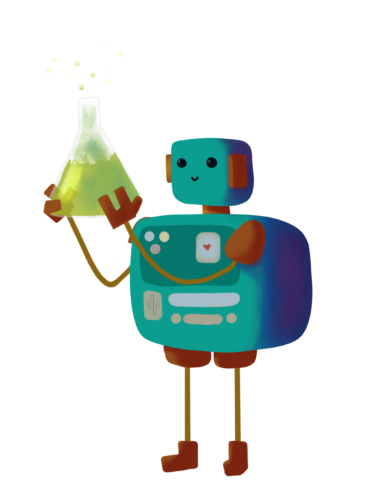Art by Malia Kuo.
For thousands of years, human innovation has been defined by the creation of big tools: the wheel, the watch, the scythe. Only in the last two centuries have we begun to investigate the power of small tools: molecules. From synthetic dyes to life-saving medications, molecular toolmaking has the potential to solve some of society’s greatest technological challenges.
But making molecules isn’t easy. The synthesis of small organic molecules usually requires very specific reaction conditions—a tailored combination of solvents, temperature, pressure, and catalysts—to maximize product yield. Knowing which conditions suit which reactions takes expertise, the kind of expertise that only organic chemists, after years of highly specialized study, possess.
“Right now, molecule making is this very exclusive club that only a few of us can get into,” said Martin Burke, a professor of chemistry at the University of Illinois at Urbana-Champaign. “We want to shatter those barriers and invite everyone into the molecule-making space.” A recent collaboration between Burke and his colleague Bartosz Grzybowski, a professor at the Polish Academy of Sciences, is working to achieve just that. The paper, titled “Closed-loop optimization of general reaction conditions for heteroaryl Suzuki-Miyaura coupling,” was published in Science in October. Together, the two teams of researchers searched for a way to optimize general conditions—conditions that, regardless of the building blocks used, maximize the final product of a reaction. In particular, they investigated Suzuki-Miyaura cross-coupling (SMC), the quintessential reaction for carbon-carbon bond formation.
With so many factors affecting a reaction, finding the best combination to optimize yield is enormously challenging. “The haystack is astronomical,” Burke said. “It’s literally beyond the capacity of collective capability of our planet.” The researchers needed a way to shrink this haystack—to find a list of possibilities for general conditions, then test them as quickly and accurately as possible.
The solution? Artificial intelligence and robots.
At the Beckman Institute in Illinois, robots performed 530 chemical reactions. Syringes, purification columns, and pipettes were connected by masses of tubing, all of which worked in sync to carry out experiments independent of human hands. It wasn’t humans typing in which conditions the robots should use, either—it was AI. Grzybowski and his colleagues developed a machine learning algorithm to instruct the robots on which conditions to test.
The process was a closed loop: Once a reaction had been performed, the data was transferred to the AI. The algorithm then developed altered procedures and transferred them back to the robot, which performed the reaction again under this new set of conditions. Then the cycle repeated.
“The AI was in Poland. The robots are in Illinois. The loop was happening across the world,” Burke said.
Burke and his colleagues had tried defining general conditions before. In 2009, they published a paper in the Journal of the American Chemical Society which used human-guided experimentation to identify general reaction conditions for the SMC reaction. It was the best that humans could do, and it took six years.
Within four months, artificial intelligence doubled their yield.
The implications of this result are far-reaching. The scientists’ ultimate goal is a “plug-and-play” platform in which researchers can enter the desired function for a molecule and have robots create it for them. With this type of technology, the synthesis of organic molecules could be democratized, no longer limited to a small group of experts. Ideally, this platform would use a limited number of reactions—maybe even just one.
“Right now, in chemistry, there are about fifty to one hundred thousand reaction types. And it all might be unnecessary, in some sense,” Grzybowski said. “Nature uses very few operations, but repeatedly, in an iterative fashion. The robots are trying to do exactly the same.”
Part of the algorithm’s success hinged upon its ability to probe both negative and positive results. “The AI was learning not only what works, but also what doesn’t work,” Grzybowski said. “With failure, the robot learns. And then it finds the right path.” For this algorithm to succeed, negative results were just as important as positive ones. This is a notable departure from how the scientific field currently works: people don’t publish negative results. For Burke, this was an important lesson.
“We don’t spend a lot of time trying to figure out why things fail,” Burke said. “We’re always trying to teach AI about how to do the things that we do. I think things just flipped. AI is teaching us something very important about how to do science. I feel like I learned something from AI, and that’s exciting.”

